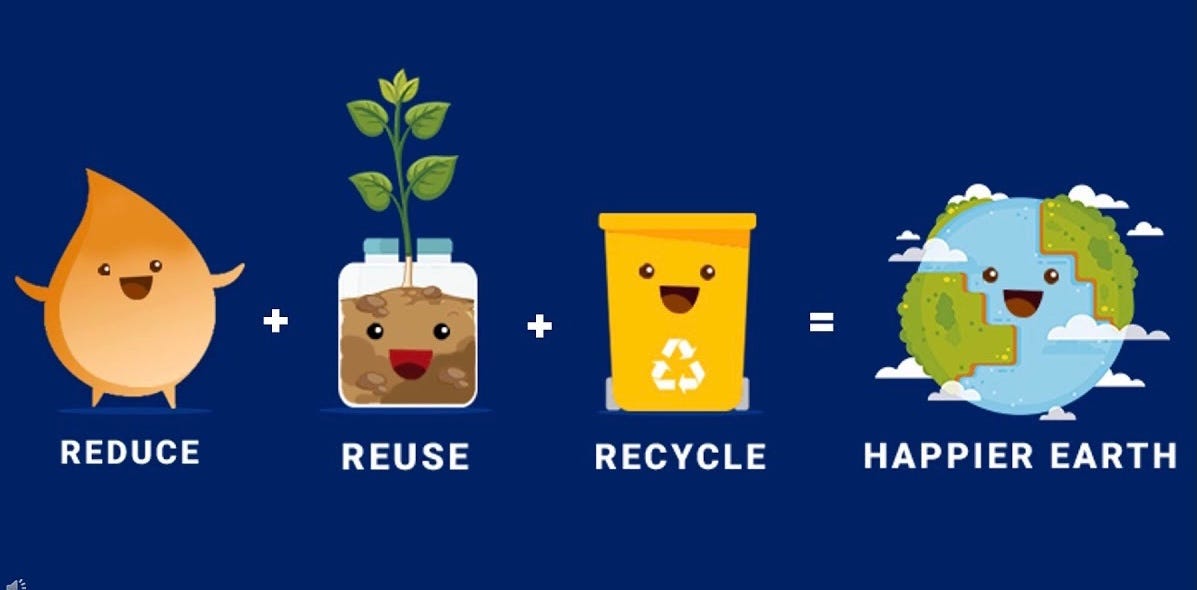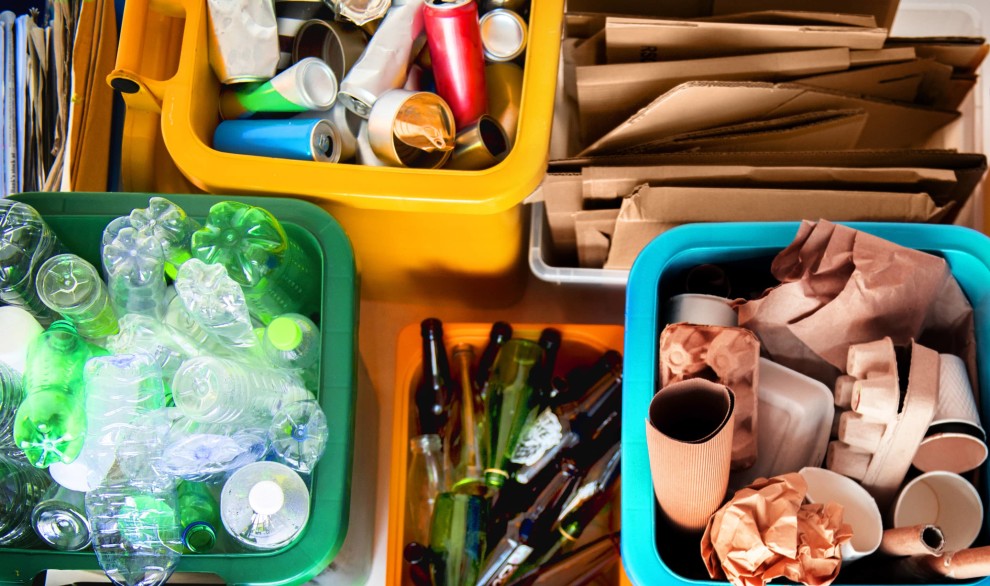Reducing, reusing, and recycling waste helps save resources.
It prevents pollution, and reduce greenhouse gas emissions that contribute to climate change.
This article explains the environmental benefits of the 3Rs in detail.
How Does Reduce Reuse Recycle Help the Environment?

Practicing reduce, reuse, and recycle principles mitigates climate change, conserves finite resources, reduces pollution, saves energy and money, and builds a more sustainable future.
Key Points
- Recycling 1 ton of paper reduces greenhouse gas emissions equivalent to taking 1 car off the road for 1 year.
- Reusing a glass jar saves the energy required to melt it down and make a new one.
- Reducing consumption lowers energy demands and resource usage across entire supply chains.
Why is Reducing Waste Important?

Reducing waste prevents pollution by stopping it at the source.
It also reduces the need to harvest raw materials, manufacture new products, and transport goods.
This saves energy and water resources while minimizing impacts on the planet.
Simply by buying less and being mindful of consumption habits, we can reduce waste generation and environmental damage.
How Does Reusing Save Resources?
Reusing materials, containers like coffee cups, and other items conserves natural resources and energy.
It takes far less energy to clean and reuse a glass jar than to recycle it or create a new one.
Reusing also prevents additional waste from being created.
Whether it’s reusing plastic containers, donating old clothes, or repairing appliances, reusing maximizes the lifecycle of products.
This saves money while reducing waste and demand for new goods.
What Are the Benefits of Recycling?
Recycling prevents waste from being disposed of in landfills or incinerated.
It reduces the need for extracting and processing raw materials.
Recycling saves energy, water, oil, and other resources.
It also reduces air and water pollution by decreasing emissions, effluents, and solid waste.
Recycling paper, for example, uses 60% less energy and 50% less water compared to making paper from trees.
Overall, recycling is essential for reducing greenhouse gases and saving finite resources.
How Do the 3Rs Fight Climate Change?
Practicing reduce, reuse, and recycle principles helps mitigate climate change.
Recycling reduces greenhouse gas emissions from manufacturing, transportation, and landfills.
Reusing goods eliminates these impacts entirely.
Reducing consumption also lowers energy demands and fossil fuel usage across supply chains.
By recycling instead of extracting raw materials, we avoid emissions from mining equipment and transportation.
Together, the 3Rs result in lower carbon emissions and energy consumption, contributing to the fight against global warming.
Can Recycling Really Save Trees?
Yes, recycling paper products saves trees, though the exact numbers are debated.
Recycling one ton of paper can save 17-24 trees.
Some argue this oversimplifies the issue since paper comes from tree farms, not forests.
However, recycling still reduces pressure on forests.
Paper production uses large amounts of energy, chemicals, and water.
By reusing paper and recyclinginstead of harvesting trees, we can conserve these resources and reduce habitat destruction.
Though we may never stop using trees for paper, recycling allows us to meet paper demands while minimizing our eco-footprint.
How Does Recycling Help Save Landfill Space?
When we recycle materials, less waste ends up in landfills.
Modern landfills are designed to prevent pollution, but many older sites still leach chemicals.
Landfills also emit methane, a potent greenhouse gas.
Recycling significantly cuts down on waste volumes, saving landfill space.
Aluminum cans take up a huge amount of space compared to their recycled material.
Recycling just one aluminum can saves enough energy to run a TV for 3 hours.
For plastics, about 90% of material value is lost when landfilled instead of recycled.
Overall, recycling conserves space and reduces waste volumes destined for landfills.
Can Reusing Reduce Water Pollution?
Yes, reusing materials such as containers, bags, and other items results in less waste and reduces water pollution.
Plastics and other trash often end up in waterways, degrading water quality.
Reusing items instead of discarding them prevents additional waste from ending up in lakes, rivers, and oceans.
Waste incineration and landfill leachate can also contaminate ground and surface water.
By generating less waste overall through reusing items, we keep more trash out of waterways and municipal waste systems.
This improves water quality.
How Does Composting Help the Environment?
Composting food and yard waste reduces landfill contributions while creating an organic fertilizer that enriches soil.
It improves soil health which is essential for agriculture, gardens, and lawns.
Compost adds vital nutrients and improves moisture retention in soils.
It can also bind and degrade pollutants in contaminated soils.
Large-scale composting diverts huge waste volumes from landfills.
An added benefit is avoiding landfill methane emissions which are potent greenhouse gases.
However, composting food waste does release some greenhouse gases.
Overall, composting is an environmentally beneficial way to recycle organic matter.
Can Recycling Be a Cost-Saving Measure?
Yes, there are financial incentives to recycling.
While some recycling programs cost cities money, the environmental benefits outweigh the costs.
Recycling reduces waste management budgets by diverting materials from landfills and lowering municipal waste quantities.
It saves tax dollars spent on landfill construction and operations.
Recycling can also support green jobs.
For citizens, recycling aluminum, other metals, and glass provides direct income in many states.
Reducing waste also saves money by decreasing purchasing and disposal costs for individuals, businesses, and cities.
Overall, recycling offers significant cost-saving opportunities if implemented properly.
How Does Recycling Reduce Pollution?
By reducing the need for raw material extraction and manufacturing, recycling decreases pollution across these lifecycle phases.
It results in lower air emissions, effluent discharges, and solid waste generation compared to virgin material production.
Recycling paper, metals, plastics, e-waste, and other materials decreases pollution from mining, logging, oil and gas extraction, refining, pulp and paper production, and manufacturing.
At disposal phase, recycling reduces air and water emissions from incinerators, minimizes landfill leachate, and prevents methane generation.
Across every lifecycle phase, recycling is far less polluting than extracting and processing virgin materials.
How does reduce reuse and recycle benefit the environment?
Reducing, reusing, and recycling materials provides enormous benefits for the environment.
It conserves natural resources, saves energy, reduces pollution and greenhouse gas emissions, minimizes habitat destruction, and decreases the need for landfill space.
Recycling alone prevents millions of tons of materials from being disposed of each year.
This avoids landfill methane and incineration emissions while also reducing the need for new raw materials.
Reusing goods is even more impactful, as it can eliminate waste entirely.
Even simple steps like reusing bags or repurposing containers prevent new items from being manufactured.
Reducing consumption tackles the problem at the source by lowering resource demands.
Together, reducing, reusing, and recycling waste are some of the most effective ways individuals and communities can reduce their ecological footprint.
These practices mitigate climate change, benefit local wildlife and habitats, conserve resources for future generations, and build a more sustainable society.
How do the 3 R’s help the environment?
The 3 R’s of reducing, reusing, and recycling provide enormous benefits for the environment across the entire lifecycle of materials and goods.
Reducing consumption decreases energy demands, resource extraction, manufacturing impacts, transportation pollution, and waste.
Reusing items prevents additional waste generation while saving the energy and resources required to create new products.
Recycling reduces the need for landfilling and incineration while lowering greenhouse gas emissions and pollution levels associated with raw material harvesting and processing.
By preventing waste in the first place, reusing materials, and recycling goods at their end of life, we can make tremendous progress toward building a zero-waste circular economy.
Practicing the 3 R’s leads to natural resource conservation, pollution reduction, climate change mitigation, cost savings, and a more sustainable society.
The 3 R’s are simple daily choices that collectively make a huge difference for environmental health.
How does reducing waste help the environment?
Reducing waste at the source is one of the most effective ways to lower our environmental footprint.
By buying less, avoiding excess purchases, and reducing food waste, we decrease demands for raw materials, energy, and transportation.
This avoids the impacts associated with resource extraction, manufacturing, and distribution of goods.
Preventing waste generation eliminates the need for waste disposal, lowering contributions to landfills and incinerators.
Studies show the average American generates over 4 pounds of trash per day.
A small daily reduction in waste production can lead to massive environmental benefits when multiplied by an entire community and over time.
Reducing waste saves money while conserving natural resources and energy.
It helps protect biodiversity and ecosystems by reducing pressures like deforestation.
Most importantly, minimizing waste tackles environmental problems at the source instead of trying to manage it after the fact.
Key Takeaways:
- Practicing reduce, reuse, recycle principles is one of the most effective ways individuals and communities can minimize their environmental footprint.
- Reducing consumption, reusing materials, recycling, and composting all result in natural resource conservation, pollution reduction, financial savings, and lower greenhouse gas emissions.
- By preventing waste generation, reusing goods, recycling materials, and composting organics, we can mitigate climate change, conserve finite resources, and build a sustainable future.
FAQ
What are other benefits of recycling?
Recycling allows us to meet material demands while minimizing the extraction of finite natural resources. It also creates jobs in the recycling and reuse industries.
Does reusing really make a difference?
Yes, reusing goods before recycling or disposing of them is one of the most effective ways to reduce waste, save resources, and prevent pollution.
Why is reducing consumption important?
Reducing consumption tackles the problem at the source instead of trying to manage waste after it is created. Lower demand reduces energy usage, resource extraction, manufacturing impacts, transportation emissions, and waste.
How does composting help reduce methane emissions?
Composting diverts food and yard waste from landfills, where it would generate methane, a potent greenhouse gas. Large-scale composting significantly reduces landfill methane.
Can recycling programs save cities money?
Yes, recycling reduces waste budgets by diverting materials from costly landfills. It also reduces long-term environmental cleanup costs. Proper recycling programs create green jobs and can generate income.
The writers at GreenChiCafe are passionate about the environment and sustainability.
Please check out the GreenChiCafe website for more in-depth content on reducing your environmental impact.
